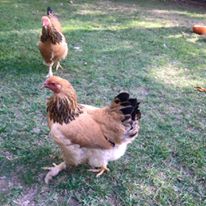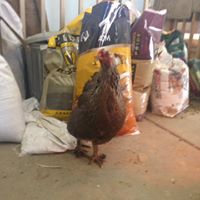
Young Buff Brahmas
This brute of a breed may seem large and charge but the reality is, they’re amongst the sweetest most docile of breeds. The gentle giants come well equipped with amazing feathered feet and a small rose comb. Making them perfect for colder climates! Originally from India, Brahmas were intended as meat birds. However, it was realized that they lay 3-4 medium-large brown eggs a week even throughout the winter. Soon after, they became known as a dual-purpose breed. They have a longer egg-laying life, do in part to their limited weekly quota. I myself have Brahma hens heading into their fifth season of laying! Looking for a great dual-purpose heritage breed chicken? Well, Brahmas top the list for being both great meat birds and wonderful layers.
What about the roosters?
The roosters are as docile as their female counterparts. Their large size does seem to instill a bit of fear amongst small children and timid adults. The males I have can be easily handled and picked up. Did you see the video that went viral last year with the larger than average light Brahma rooster? Wow, he was a big boy, to say the least! Now that one might even scare me a bit if it was headed my way. (Giant Brahma Video) Roosters can weigh in as much as 18.25lbs – though 12lbs is average. Compared to hens who can come in at 13lbs. However, most are around 10lbs.

Mr. Brahma
Fun Facts!
Brahmas come in an array of colors but only three are recognized buff, light, and dark. Want some flare in your flock? Check out some of the amazing unrecognized color variations partridge, blue, and even gold-laced. You can now even obtain a bantam (miniature) variety! Who doesn’t want small Brahmas running around everywhere? They make great show birds! Not only for their amazing plumage but for their sweet disposition with children. I have heard they are also amongst the best mommies and setters. I myself, have had many Brahmas, none of which either set or mothered any chicks for me. That’s ok though, I love them for their amazing disposition and cold-weather tolerance more than anything.

Brahma Mama, my very favorite hen, please don’t tell the others. (5 years old and still laying)
What else should you know?
Those feathered feet may require a little extra care from time to time. Often getting mud, poop, snow, and even ice attached and caked on. A quick soak in a bucket of warm soapy water makes quick work of it. I even trim the hairs on occasion in the muddy season; it helps to ensure less clumping. They are easy to contain, thanks in part to their large size, so keeping them in a pasture is no problem at all. Have a confined space? That’s ok; they do well in confinement. The Brahma breed is a slow grower, taking up to 18 months to reach full maturity. Many do not start laying until they reach 6-12 months.
Want more information on Brahmas? Check out The Livestock Conservancy
Follow Carrie on Facebook, Miller Micro Farm, Community Chickens, Mother Earth News, and Grit.













1 Comment
Good day, please how can you ship brahmas fertile eggs to Nigeria for incubation? Your Swift response will be highly appreciated.